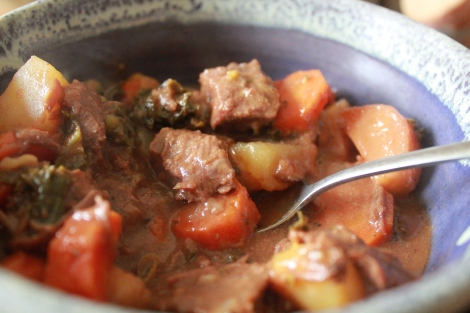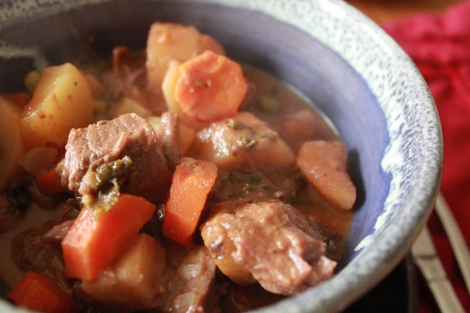So far, every recipe I’ve posted has been vegetarian. And I do generally eat a vegetarian diet, although I’m not incredibly strict about it. However, there is an exception to my general rule, and that is wild game. Ryan goes hunting every fall and he usually comes home with a deer or an elk, which comprises our main meat source over the year until the next fall comes around.
This is one of my favorite ways to cook elk or deer meat. It’s a thick stew, which cooks all day, sending warming fingers of savory goodness through my home all day long. The meat is tender and falls apart at the touch of a fork; the vegetables are surprisingly firm considering the cooking time. The sauce is thick and savory, perfect for mopping up with a thick slice of crusty bread.
This makes a delicious Sunday supper, and a good dish for company because you can have it in the slow cooker long before anyone shows up, making a diner party less stressful. The last time I made it, I served it with this apple salad, this Artisan bread, and lovely green salad brought by our guests.
Before I give you the recipe, though, I think an explanation of wild game versus conventional meat is in order; if you’re not interested, skip down to the recipe below.
I don’t avoid meat for ethical reasons, really, although I am disturbed by the environmental impacts of the way we raise meat in the Western world, and the inhumane treatment of animal on most factory farms these days. However, health is a top reason for my diet choices. The high level of meat consumption in the Western diet has been continually linked to our skyrocketing rates of chronic disease and obesity. But, there are lots of reasons why wild game is a completely different food source than the meat sold at a typical U.S. grocery store, fast food joint, or restaurant, all of which generally comes from a Concentrated Animal Feeding Operation. This is the source of basically any meat for sale, unless it’s specifically labeled grass-fed and organic (and even then, you might want to check in with the farmer to be sure).
CAFO-raised animals live in tight, generally unsanitary quarters (which has both environmental impacts from so much manure in one spot and health impacts, primarily E. coli outbreaks, resulting from manure containing the virus clinging to the animals’ hides and then getting into the meat. One tainted cow can infect millions of hamburger patties, as slaughterhouses make enormous batches of ground beef.) To save on costs, CAFOs feed animals grains (which for many decades have been artificially cheap because of the subsidies provided in the Farm Bill) instead of allowing them to roam on pastures and eat grass. However, cows aren’t designed to eat corn, so it causes numerous health problems for them, and CAFO operators have to pump the animals full of antibiotics to keep them going until butchering time. It turns out that the saying, “you are what you eat” applies to the animals we consume as much as it does to us. So when cows eat an unhealthy and unnatural diet of grains and antibiotics, and lead a sedentary lifestyle in a cramped CAFO, it increases their body fat percentage (just like for people) and throws their ratio of good to bad fats out of whack. Here’s a great chart showing the difference between fat levels and types of fats in different meats:
To me, these are amazing statistics! Ground beef has almost 8 times the saturated fat that venison does. Plus, there is about 9 times as much monounsaturated fats as polyunsaturated fats in ground beef, compared to a fairly even ratio in venison. This matters because, although neither saturated fats or monounsaturated fats are essential nutrients, polyunsaturated fats are very important for our bodies. Omega-6 and omega-3 fats, which have gotten lots of press lately, fall into this category, and play an essential role in health. They help build the brain, lower blood pressure, decrease inflammation and pain, improve nerve and immune function, help insulin work (essential for avoiding diabetes), and affect vision, coordination, learning ability, and mood because of their impact on the brain.
Amazingly, although Americans eat record levels of fats, most of us are deficient in these essential fatty acids. (For a great discussion on this, see The New Optimum Nutrition Bible, chapter 9, by Patrick Holford.) This isn’t surprisingly when you look at the chart above. In order to get .8 grams of polyunsaturated fatty acids from ground beef, you have to consume 8 grams of saturated fats and 9 grams of unsaturated fats. With venison, you’ll only get 1.25 grams of saturated fat and .8 grams monounsaturated for every gram of polyunsaturated fats. So, I feel a lot differently about eating venison, not only for the fat issue, but also because I feel like the animal led a nice life in the mountains, and we’re not contributing to antibiotic resistance, environmental disasters, or pathogenic outbreaks when we eat it.
I don’t know how many of you can get your hands on some fresh venison. But if you can, this is a great way to use it. If you haven’t tried venison before, don’t be deterred by reports of it being gamey. It’s delicious! I like the taste much, much better than beef, in fact. It is more flavorful, and far less fatty. When cooked like this, it’s so tender too. If you can’t find any venison or elk meat, though, beef would certainly work (although I hope I’ve convinced you to invest in grass-fed, organic beef).
Special Diets & Allergies: Nut free, soy free, dairy free if you use a non-dairy milk
Venison Stew (Winter Sunday Dinner)
Serves 8
This thick venison stew is a non-conventional twist on an American classic. The meat is tender, the sauce thick and savory, and every bite is loaded with chunks of vegetables. You can play around with what vegetables you use. Chopped cabbage is nice, and you can certainly add more kale. I think the peas, carrots, and potatoes are a necessity, although I’d love to swap some or all of the potatoes for parsnips. Make sure you don’t shortchange the cooking time here. The meat will be done long before the cooking time is up, but the meat really tenderizes during the last few hours, and the difference between cooking it for 8 and 10 or 12 hours is quite surprising. Also, I woudlnt’ cook this on high; I don’t think you’ll get the same result.
Ingredients:
1 1/2 lb of venison (or enough to fill a fourth to a third of your crockpot) cut in 1 to 1 1/2″ chunks
3 C potatoes, peeled and chopped in 1/2″ chunks
2 C carrots, peeld and chopped in 1/4″ rounds
1 C frozen peas
3 C chopped curly kale
4 T olive oil
1/2 yellow onion, minced
1 t thyme
1 t oregano
1/2 t garlic powder
1 t salt
1 t sage
2 T whole wheat flour
3 T all purpose flour
2 C milk of choice (I like unsweetened almond milk)
2 8 oz. cans tomato sauce
Directions:
-
Place the venison in the crockpot, layer with the potatoes, carrots, peas, and kale.
- Heat the olive oil in a skillet over medium-high heat. Sautee the onions until they are tender. Meanwhile, combine the flours, spices, and salt in a small bowl.
- Reduce the heat to medium.
- Add the flour mixture to the onions in the pan and quickly stir to coat all of the flour in oil.
- Slowly pour in the milk, quickly whisking the mixture to make sure there are no lumps.
- Cook the milk, stirring constantly and scraping the bottom of the pan, until the mixture begins to thicken. When it is thick and bubbly, turn off the heat and stir in the tomato sauce.
- Pour the mixture on top of the vegetables in the crockpot. Make sure all of the kale is covered with sauce.
- Place the lid on the crockpot and cook on low for 10 to 12 hours or until the meat is tender and falling apart.




I remember you made this once for dinner when we came over. This was the first time I had tried venison, before I was a little freaked out to give it a try. It was delicious!! I love your stew!
It’s so yummy, isn’t it?! Do you guys have any elk/venison these days? I’d love some more recipes for it. I honestly only have a few, this being the main one. It’s hard to substitute it in anything that’s cooked quickly because it’s tougher than beef.
Pingback: National Food Allergy Awareness Week: A Roundup of Allergy-Friendly Dishes | The Joyful Pantry·